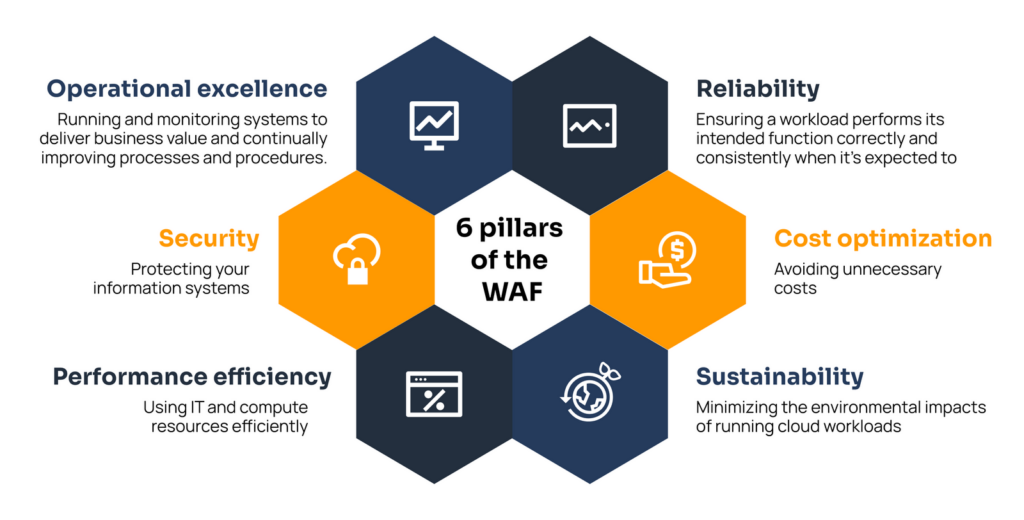In today’s cloud-first digital landscape, building a solid and secure cloud infrastructure is not just an option; it’s a necessity. This is where the Well-Architected Framework Review (WAFR) comes into play.
The WAFR is a systematic approach to evaluating cloud architectures, helping your team identify and fix potential issues before they escalate.
As defined by AWS, the Well-Architected Framework encapsulates key concepts, design principles, and architectural best practices for creating and running workloads in the cloud. Its goal is to guide you in making informed decisions while structuring systems on AWS, Azure, or Google Cloud.
AWS Well Architected & the 6 Pillars:
- Operational Excellence
- Security
- Reliability
- Performance
- Cost Optimization
- Sustainability

Why is WAFR Critical in the Cloud Environment?
A WAFR provides invaluable insights into your architecture’s efficiency and security, revealing areas for improvement. It’s like a health check for your cloud-based systems, ensuring they are well-designed, stable, and secure.
Neglecting to conduct a WAFR can lead to serious consequences. For example, without regular reviews, you could miss out on identifying potential vulnerabilities in your cloud infrastructure, leaving your system open to cyber threats.
The WAFR Process: Not as Daunting as You Might Think
Despite its critical role, the WAFR process isn’t overly complex or time-consuming. It involves five straightforward steps: preparation, review meeting, read-out, quick wins, and follow-up review.
During the review, you’ll assess your current architecture against the framework’s best practices, identifying areas where you’re doing well and those that need attention. This process helps you prioritize improvements for more significant impact, ensuring your architecture is robust and resilient.
What are the 6 Pillars?

Step 1: Operational Excellence
The journey to a well-architected framework begins with a thorough evaluation of both internal and external customer needs, governance needs, compliance requirements, threat landscapes, and trade-offs. It also involves advocating for a work culture that values clear communication, experimentation, and resource allocation to promote both team growth and operational excellence.
Step 2: Preparation
Before embarking on the review, it is paramount to establish processes for identifying key performance indicators and implementing application telemetry. It is equally important to promote operational readiness and have a solid plan to mitigate deployment risks. Proactive measures to this end include using version control, automating integration and deployment, planning for unsuccessful changes and testing deployments.
Step 3: Operation
An effective review takes a deep dive to understand the health of operations by measuring goals, KPIs, and reviewing operations metrics. During this phase, managing workload and operations events is a main point of focus, and procedures are put in place to automate responses to events. It’s during this phase that businesses begin to see the fruits of their labor, with a refined process that ensures a continuous improvement cycle.
Step 4: Security
One cannot underestimate the importance of security in a well-architected framework review. This stage involves securing workloads, managing authentication and permissions, and detecting and investigating security events. This acts as a foundation for protecting the business and ensuring data integrity. It also extends into incident response, with an emphasis on preparation for, and response to, security incidents.
Step 5: Reliability
The final stage of the review process is ensuring reliability. This involves managing service quotas, planning network topology, designing interactions and managing change and backing up data and protecting against failures. The goal here is to create reliable and robust architecture that can withstand adversity and ensure uninterrupted service.
What’s next?
The well-architected framework review process is a conversation-based approach that aims to identify areas of improvement in your architecture. Conducting a review early and continuously throughout the product lifecycle helps uncover risks, address issues, and create a more efficient and reliable architecture. It is a blame-free exercise that encourages a deep dive into your architecture.
Remember, the aim of a well-architected framework review is to create a robust, secure, and reliable architecture that can ensure smooth operations for your organization. A successful review can give you peace of mind, knowing your architecture is well-architected, stable, secure, and ready for the future.
Looking for additional support?
AWS Well-Architected Lenses extend the guidance for your organization via education and white papers for specific industry and technology domains, including but not limited to: machine learning (ML), data analytics, serverless, high-performance computing (HPC), and others.
Moving past the framework and lenses…
Amazon also provides dedicated white papers focusing on specific topics to support your team as they are focusing on specific use cases.
A ClearDATA, we understand the nuances of conducting a thorough WAFR. Our team of experts can assist you in navigating this process, ensuring your cloud infrastructure is not only well-designed but also secure and reliable.
By partnering with us, you can leverage our extensive experience and expertise in the field, allowing you to focus on what matters most – your business operations. Don’t leave your cloud security to chance. Contact us today to learn more about how we can help you conduct a Well-Architected Framework Review, ensuring your cloud infrastructure is both secure and efficient.


